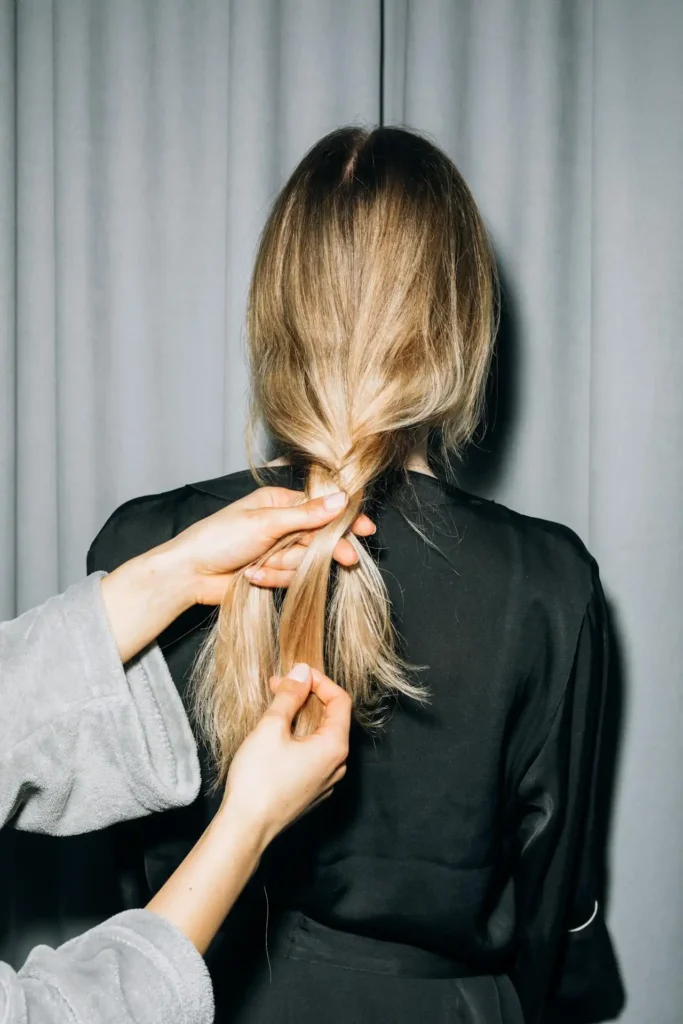How to Use a Flat Iron Without Frying Your Hair
You love the sleek, polished look that a flat iron creates, but you worry about damaging your hair.
The good news? You can achieve gorgeous, straight styles without turning your locks into brittle, fried strands.
With the right techniques and preparation, you’ll master heat styling while keeping your hair healthy and strong.
Start With Clean, Dry Hair

Your flat iron journey begins in the shower. Clean hair accepts heat styling much better than dirty, product-laden strands.
When you wash your hair, focus on removing all buildup from oils, styling products, and environmental pollutants.
After washing, you must completely dry your hair before reaching for your flat iron. Your hair should feel completely dry to the touch before you begin flat ironing.
Wet or damp hair literally steams when it meets high heat, causing severe damage to your hair shaft.
This steaming effect breaks down the protein structure in your hair, leading to breakage and split ends.
Use a blow dryer or air-dry your hair completely. If you’re in a rush, focus the blow dryer on your roots first, then work your way down to the ends.
Choose the Right Temperature for Your Hair Type
Not all hair needs the same amount of heat. Fine or damaged hair requires much lower temperatures than thick, coarse, or virgin hair.
You’ll need to find your hair’s sweet spot to achieve smooth results without causing damage.
Start with the lowest effective temperature for your hair type. Fine or chemically treated hair works best at 250-300°F.
Medium-textured hair typically needs 300-350°F. Thick, coarse, or resistant hair may require 350-400°F, but never exceed 450°F.
Test a small section first. If your hair straightens easily at a lower temperature, stick with it.
You can always increase the heat slightly if needed, but you can’t undo heat damage once it occurs.
Many modern flat irons display the exact temperature, making it easier to control.
If your flat iron only has numbered settings, start at the lowest setting and gradually increase until you achieve the desired results.
Apply Heat Protectant Like Your Hair’s Life Depends on It
Heat protectant products create a barrier between your hair and the flat iron’s plates.
These products contain silicones and polymers that coat your hair shaft, reducing direct heat contact and moisture loss.
Apply heat protectant to damp hair before blow-drying, or to completely dry hair before flat ironing.
Focus on your mid-lengths and ends, which are the oldest and most fragile parts of your hair. Don’t forget the underneath sections that you might miss.
Choose a heat protectant that matches your hair’s needs. Lightweight sprays work well for fine hair, while thicker creams suit coarse or damaged hair.
Some products offer protection up to 450°F, while others protect against lower temperatures. Allow the product to distribute evenly through your hair.
Comb through with a wide-tooth comb or brush to ensure every strand receives protection. This step takes an extra minute but saves you from months of hair repair.
Section Your Hair Strategically
Proper sectioning ensures even heat distribution and prevents you from passing over the same area multiple times.
Working with smaller sections also allows your flat iron to grip and smooth each strand more effectively.
Divide your hair into horizontal layers, starting from the bottom. Clip the upper sections out of your way with hair clips or hair ties.
Create sections that are roughly one to two inches wide, depending on your hair’s thickness and length.
Start with the bottom layer at the nape of your neck. Work your way up systematically, releasing one layer at a time.
This method ensures you don’t miss any sections and prevents tangling. Smaller, uniform sections allow for more efficient styling with less damage.
Keep your sections consistent in size. Larger sections require more passes with the flat iron to achieve smoothness, which increases heat exposure.
Master the Proper Flat Iron Technique

Your technique determines both your results and your hair’s health. Slow, steady movements with the right pressure create smooth styles without excessive heat exposure.
Place the flat iron at your roots (but not touching your scalp) and clamp down gently.
Don’t grip too tightly, as this creates dents and increases pressure on your hair shaft. Glide the flat iron down the length of your hair in one smooth motion.
Keep the flat iron moving. Stopping or hesitating in one spot concentrates heat and can literally burn your hair.
Maintain a steady pace that allows the heat to smooth your hair without lingering too long in any area.
Angle the flat iron slightly downward as you pull it through your hair. This technique smooths the hair cuticles and creates more shine.
Never pull the flat iron straight up or at odd angles, as this can cause breakage and uneven results.
Avoid the Repeat Offense
One of the biggest mistakes you can make is repeatedly passing the flat iron over the same section.
Each pass exposes your hair to more heat, and multiple passes can quickly lead to damage.
If a section doesn’t straighten completely on the first pass, check your technique before trying again.
You might need a smaller section, higher heat, or better tension. Rushing through with multiple passes almost always causes more harm than good.
Allow your hair to cool between passes if you absolutely must go over a section again.
Hot hair is more vulnerable to damage than hair at room temperature. Wait at least 30 seconds before touching up any areas.
Consider that some texture and movement can look more natural than perfectly straight hair.
Embrace slight waves or bends rather than over-processing your hair into submission.
Keep Your Flat Iron Clean and Well-Maintained
Product buildup on your flat iron’s plates can cause uneven heat distribution and snag your hair.
Clean plates glide more smoothly and transfer heat more efficiently, reducing the time and temperature needed for styling.
Clean your flat iron after every few uses. Allow it to cool completely, then wipe the plates with a damp cloth.
For stubborn buildup, use a small amount of rubbing alcohol on a cloth to dissolve styling product residue.
Check your flat iron’s condition regularly. Scratched or damaged plates can snag and damage your hair.
Uneven heating elements can create hot spots that burn your hair. Replace your flat iron if you notice any damage to the plates or inconsistent heating.
Store your flat iron properly to extend its life. Allow it to cool completely before storing, and avoid wrapping the cord tightly around the tool, as this can damage the internal wiring.
Use the Right Products for Your Hair Type
Different hair types benefit from different styling products used in conjunction with flat ironing. The right products can enhance your results while providing additional protection.
For fine hair, use lightweight products that won’t weigh your hair down. Damaged or chemically treated hair needs extra moisture and protein.
Volumizing mousses applied before blow-drying can add body, while light finishing serums add shine without heaviness.
Thick or coarse hair benefits from heavier creams and oils that provide more moisture and control.
Apply these products to damp hair before blow-drying to lock in hydration and make flat ironing easier.
Use deep conditioning treatments weekly, and consider leave-in treatments that provide ongoing protection and repair.
Time Your Flat Iron Sessions Wisely
How often you flat iron your hair significantly impacts its health. Daily heat styling, even with perfect technique, can gradually weaken your hair over time.
Limit flat ironing to 2-3 times per week maximum. On off days, try heat-free styling methods like braids, buns, or air-drying techniques that work with your natural texture.
When you do flat iron, make the style last longer by sleeping on silk or satin pillowcases, which create less friction than cotton.
Wrap your hair in a silk scarf or use a silk bonnet to maintain your style overnight. Touch up only the areas that need it rather than re-doing your entire head.
Often, you can refresh your style by focusing on the front sections or areas that get messed up during sleep.
Recognize and Address Heat Damage Early
Learn to identify the early signs of heat damage so you can adjust your routine before serious problems develop. Catching damage early allows for easier repair and prevention of further issues.
Watch for increased tangling, especially when your hair is wet. Heat-damaged hair loses its smooth cuticle layer, causing strands to catch on each other more easily.
Notice changes in your hair’s texture. Heat damage often makes hair feel rough, dry, or straw-like. Your hair might also lose its natural elasticity and break more easily when stretched.
Pay attention to split ends and breakage. While some breakage is normal, increased splitting or shorter broken pieces throughout your hair indicate heat damage.
If you notice these signs, reduce your flat iron use and focus on deep conditioning treatments. Consider getting a trim to remove damaged ends and give your hair a fresh start.
Create a Protective Hair Care Routine

Building a hair care routine that supports your heat styling habits helps maintain your hair’s health over time.
Consistent care makes a significant difference in how your hair responds to regular flat iron use. Incorporate protein treatments monthly if your hair shows signs of weakness
Use a deep conditioning mask once a week to replenish moisture lost during heat styling. Focus on your mid-lengths and ends, which receive the most heat exposure..
Heat styling can break down the protein structure in your hair, and occasional protein treatments help rebuild strength.
Get regular trims every 6-8 weeks to remove split ends before they travel up the hair shaft. Fresh ends also respond better to heat styling and look healthier overall.
Conclusion
Master these techniques to enjoy beautiful, straight styles while keeping your hair healthy and strong.
Your hair will thank you for the extra care and attention.







